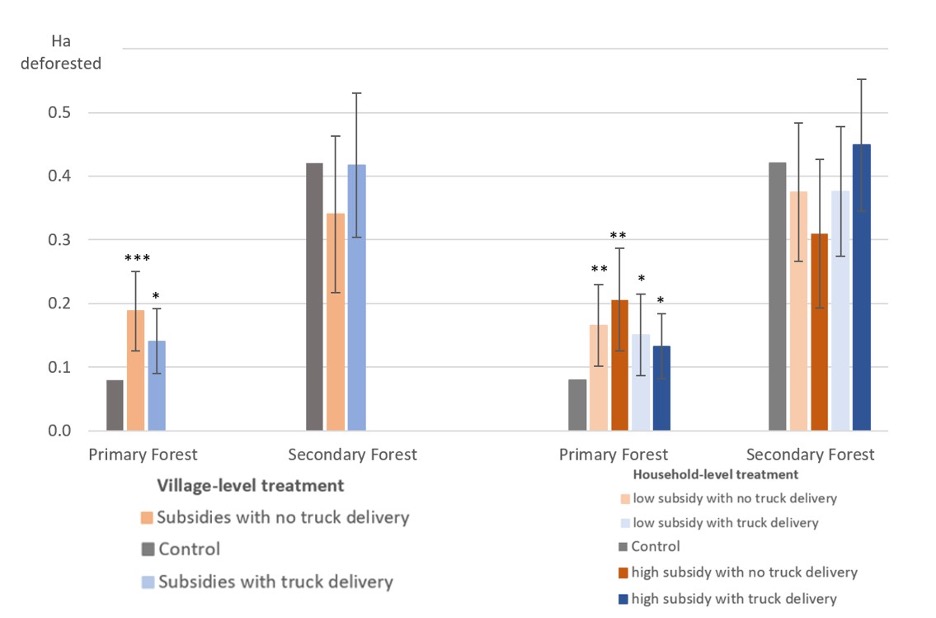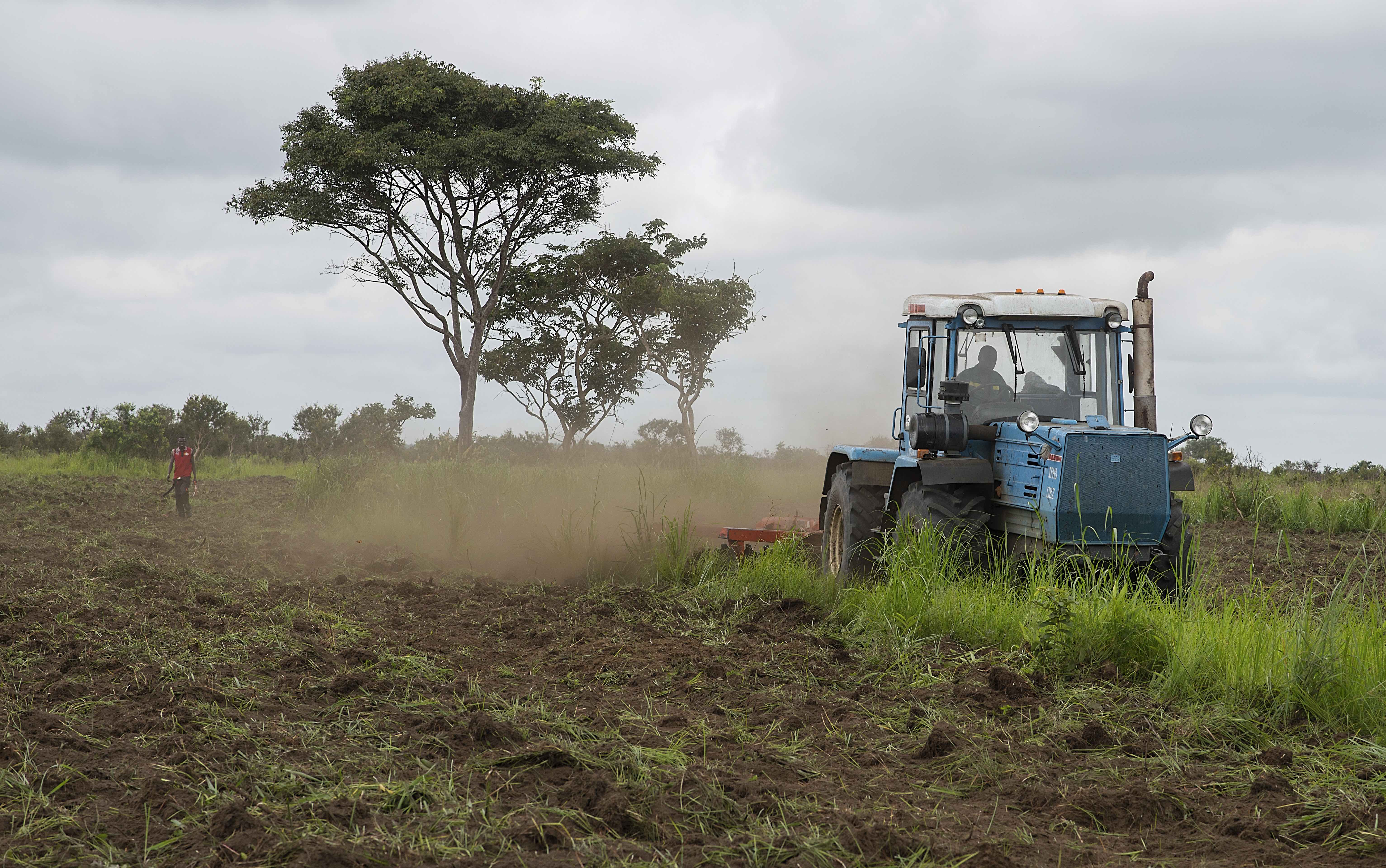Modern agricultural technologies have the potential to drive economic growth and poverty alleviation, and improve health and nutrition in many of the poorest countries in the world (e.g., Gollin et al. 2012, Von der Goltz et al. 2020). However, a lingering question remains: does this progress come at the expense of environmental sustainability? The Borlaug hypothesis posits that the availability of Green Revolution agricultural technologies (essentially modern seed varieties and fertilizers) can mitigate the expansion of cultivated land (Borlaug 2007). Yet local market dynamics and theories like Jevon’s paradox suggest a more complex local reality.
This question carries particular relevance for the Democratic Republic of Congo (DRC), home to the worlds’ second largest rainforest. Since 2000, deforestation in the Congo Basin has surged, with 90% attributed to small-scale, non-mechanized forest clearing for agriculture (Tyukavina et al. 2018). Given the rich biodiversity in the remaining primary forest, expanding cropland in this region poses a severe threat, and policies aimed at agricultural intensification are often presented as a potential solution. However, to understand the real impact of such policies on the ground, we need farm and household-level analysis that account for the complex dynamics of land use changes (Phelps et al. 2013).
Impact assessment of a large-scale promotion of modern seed varieties in the Democratic Republic of Congo
In our recent research, we delve into the causal impact of the diffusion of modern seed varieties on deforestation, focusing on the Equateur province, which encompasses a significant portion of DRC’s forest cover (Bernard, Lambert, Macours and Vinez 2023). In collaboration with the Ministry of agriculture, we designed and conducted a randomized control trial to evaluate the effects of a large agricultural project (the Agricultural Rehabilitation and Recovery Support Project (PARRSA)). This project was the primary tool deployed by the Ministry since 2011, with World Bank support, to help intensify agricultural activities in Equateur. A crucial aspect of this project involved creating a market for modern seed varieties including high yielding maize and groundnut varieties, short-cycle rice, and a disease-resistant cassava variety.
We investigate whether the program led to changes in overall deforestation (defined as the partial or complete removal of woody vegetation of a forested area) and distinguish between primary and secondary forest clearing (primary forest is defined as forest with no observable traces of cultivation, while secondary forests are more recent regrowth on land that has been previously cultivated (FAO 2020)). This distinction is essential as primary forest loss carries substantial implications for carbon sequestration and biodiversity (Ferreira et al. 2018).
Design and data
Our study encompasses 92 villages, with 60 randomly selected for a subsidy intervention, while the remaining served as control. Within treatment villages, households were randomly selected before the agricultural season to receive vouchers, allowing them to purchase modern seed varieties at subsidized prices. These vouchers could be redeemed at local seed multipliers’ stores, often located in distant urban areas. In 35 treatment villages, an additional intervention involved a truck offering seeds for sale directly within the village. The level of subsidy varied among households within treatment villages, enabling us to compare deforestation outcomes between those receiving high versus low subsidies.
We rely on remotely-sensed data from Hansen et al. (2013) to compare village-level forest-cover changes between treatment and control villages. Additionally, we use data from a comprehensive household survey representative of the smallholder farmer population in the region to connect differences in subsidy levels directly with their land-use decisions. This detailed household survey included current and historical information on all cultivated plots, including whether they were cultivated in the previous year, and whether they were cleared from primary or secondary forest. Results were cross-validated by examining farmer’s reported labor allocation to land preparation.
Result 1 – Overall deforestation is unchanged
The promotion of modern seed varieties did not lead to significant increase in the demand for land or related deforestation (Figure 1). However, it also did not reduce agricultural land use. This finding offers no strong support for either the Borlaug hypothesis or Jevon’s paradox. The inelasticity of labor supply might explain the lack of change in overall deforestation, as deforestation is a labor intensive activity and additional labor opportunities are limited so households mostly need to rely on the reallocation of a fixed labor supply.
Figure 1
Treatment effect on overall deforestation, at village and household levels
Note: Estimates from OLS regressions of hectares of forested area cleared onto treatment dummies. Bar-clusters 1, 2 and 3 report village-level treatment effects based on remotely-sensed (bar-clusters 1 and 2) and household-survey data (bar-clusters 3 and 4). Bar-cluster 4 reports household-level treatment effects, further distinguishing between higher- and lower-level subsidy levels randomized across households within treatment villages.
Result 2 – Shift from secondary to primary forest deforestation
Focusing on household-level treatment effects (Figure 2), our analysis reveals that exposure to modern varieties altered the pattern of deforestation. Treated households cleared twice as much primary forest on average than control ones, compensating by clearing less secondary forest. The effect is particularly pronounced in villages without access to truck-delivered seeds, and within those villages, households benefiting from higher subsidy levels.
Figure 2
Treatment effects on deforestation across forest types, at household-level

Note: Estimates of household-level treatment effects from OLS regressions of hectares of forested area cleared onto treatment dummies, with separate estimates for primary and secondary forests. All estimates rely on household-survey data. Bar-clusters 1 and 2 rely on village-level treatment status, while bar-clusters 3 and 4 further distinguish between higher- and lower-level subsidy levels randomized across households within treatment villages.
We hypothesize that this shift is driven by increased demand for soil nutrients generated by modern seed varieties for cereals, a demand unmet by local fertilizer markets or the government’s agricultural rehabilitation project. In the Congo Basin Forest of Equateur, the absence of fertilizers, coupled with lack of information on soil conservation practices, meant that previously uncultivated land gave the highest cereal yields. Smallholder farmers, aware of this fact from agronomists’ colonial-era land and crop rotation recommendations, accelerated the clearing of primary forest while cultivating less land converted from secondary forest or other uses.
Variation in the type of seeds that were offered to farmers provides insight into the mechanism. In villages where cereals predominated among the modern seed varieties offered (villages without truck deliveries), subsidies led to increased primary forest deforestation by beneficiary households. Conversely, in villages with a broader array of legumes available for purchase (in villages with truck delivery), modern seed variety promotion resulted in less extensive deforestation, aligning with historical recommendations favoring legume cultivation on nutrient-poor soils due to their low nitrogen requirements. It is worth noting that this finding comes with a caveat, as the original experimental design did not plan for variations in cereal versus legume availability.
Conclusion
Distinguishing between primary and secondary forest deforestation is key to understand the environmental trade-offs associated with agricultural intensification practices. While modern crop varieties hold large potential for improving livelihoods, the tension with potential negative environmental consequences must be considered in nuanced and context-specific ways.
Tanguy Bernard is a Professor of Economics at the University of Bordeaux, France, and a Nonresident Senior Research Fellow with IFPRI’s Markets, Trade, and Institutions Unit; Sylvie Lambert is a Chaired Professor at the Paris School of Economics and Senior Researcher with the French National Institute of Agricultural Research (INRAE); Karen Macours is a Professor at the Paris School of Economics and Center for Economic Policy Research (CEPR) Research Affiliate; Margaux Vinez is a Senior Economist at the World Bank. This post first appeared on VoxDev.







